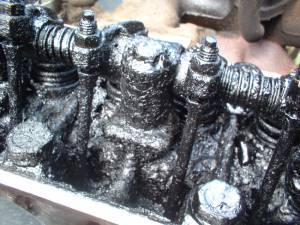What you Need to Know about Fluids
Fluids and fluid maintenance are one of the most important areas of vehicle and equipment maintenance.
The need for engine oil service is fairly well known and recognized. Oil additives that help oil perform and protect, tend to break down or get used up over time and no longer perform their functions. Additives include detergents to keep engines clean and friction modifiers to prevent wear. Oil also becomes contaminated with by products of combustion which pass by piston rings and moisture from the air which mixes with oil to form various acids. All these can lead to wear and sludge. Oil flush and oil additives can remove sludge, and extend oil life. Dirty oil can easily be observed and shown to a customer.
Transmission Fluid has four main functions which are all vital to operation and longevity. The first function is the creation of hydraulic pressure to engage various parts of the transmission to select direction and gear ratio. The second function is to transfer heat away from transmission parts. The third is to control dirt, and the forth is to allow parts to smoothly operate with minimal wear.
The base of Transmission fluid is clear hydraulic fluid that has red dye added to it for identification. It is pumped to create pressure and flows through a cooler to remove heat. The detergents added to transmission fluid are designed to keep minor dirt, such as microscopic pieces of friction material) suspended in the fluid. Much like dish detergent, the additives in transmission fluid have the ability to carry a certain amount of dirt. Once that amount is exceeded, dirt ?drops out? of the fluid and forms deposits on hot surfaces.
These deposits impede the movement of close tolerance parts leading to failure of friction components and other hard parts. The friction modifiers in fluid are added to prevent wear by allowing components to apply smoothly without shock or excessive wear. The ability of the fluid to create pressure stays very constant throughout the fluids life, however the detergents and friction modifiers do tend to wear out and are very susceptible to damage from overheating.
Fluid manufactures say that overheating as few as 2 times by 20 degrees or more will oxidize the additives to a point that they become ineffective. One quarter to one third of the fluid can be change through a drain and refill compared to 95% change with a flush. A flush product should be used in conjunction with a flush to dissolve deposits and suspend dirt in the old fluid prior to exchanging. Changing fluid without using a cleaner is like taking a bath with clean soapy water in a very dirty bathtub. The dirt doesn?t get removed it just gets redistributed. Fluid conditioners allow the fluid additives to last longer and continue to work under higher temperature conditions.
Power Steering Fluid has the same functions and characteristics as Transmission Fluid. The friction modifiers are important to prevent wear and noise especially in low speed maneuvering and the detergents keep the system operating freely. Early warning signs of fluid break down are usually poor assist cold (morning sickness) and noise or chattering during parking maneuvers. Failure to address the fluid problems leads to costly parts replacement. Adding Cleaner and replacing fluid is a prudent maintenance service.
Engine coolant has multiple functions also. It removes heat from the engine, and provides a heat source for the HVAC system. It also is often used to remove heat from transmission fluid, engine oil, and sometimes even power steering fluid.
A complex combination of components allows coolant to perform these functions effectively. These components vary greatly based on the type of coolant used. There are four main factors to consider when checking coolant. The first is color and condition. If coolant has discolored from corrosion or contamination it will not perform properly and should be flushed after source of contamination repaired. The second factor is freeze protection. The third is the PH level. When not in the proper range, the PH level of coolant attacks and destroys components from soft plugs to radiators. The fourth main factor is age.
Certain additives in coolant no longer stay bonded over time and separate from the coolant. Silicate Drop Out can actually lead to the formation of deposits that lead to restricted flow that can cause major engine damage. Cleaning and back flushing are prudent repairs along with addition of conditioner to control PH.
One more fluid that requires special attention is Brake Fluid. Brake fluid is used to create pressure and remove heat. When brake fluid ages it absorbs water, lowering its boiling point and creating a corrosive mixture that attacks brake system parts from the inside. An indication of the fluids condition is the copper content which is actually a result of corrosive fluids attack on the brake lines.
Enertech Labs, Inc. offers products, service equipment, and training to allow users to provide the best service at the lowest cost possible.


